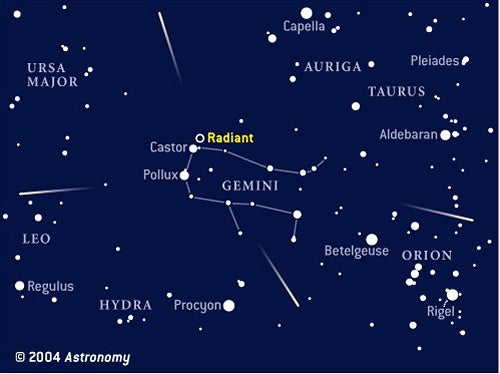
Astronomy‘s mission:
Astronomy promotes the science and hobby of astronomy through high-quality publications that engage, inform, entertain, and inspire.
More Astronomy resources:
- Astronomy news
This week’s sky events
Astronomy basics
Glossary of astronomical terms
Return to Astronomy “For the media” page
WAUKESHA, WI — The annual Geminid meteor shower, which peaks the night of December 14/15, is typically one of the year’s best. Occurring less than a month after the Leonids, the Geminid shower generally features brighter meteors. In 2007, the Moon will be a waxing crescent setting in midevening, so its light will have little effect on viewing.
The Geminids are so named because, if you trace all the meteor trails backward, they would meet within the boundaries of the constellation Gemini the Twins. This point, called the radiant, lies approximately 3° northwest of the 1st-magnitude star Castor.
Astronomy magazine editors are available to discuss this spectacle. To request an interview, please contact Matt Quandt at 262.798.6484 or mquandt@kalmbach.com.
This year’s Geminid meteor shower
Geminid meteors are relatively slow moving, and many leave smoke trails that can last a few seconds. In 2007, the shower will be active from about December 7 to 17, but the peak (the best time to see them) occurs the night of December 14 and the morning of December 15. The Geminid meteor shower has a broad peak, so observers should see an excellent show all night.
“The Geminid meteor shower usually produces a good percentage of bright meteors,” says Astronomy magazine Senior Editor Michael Bakich, “so it’s worth watching even under less-than-favorable conditions. In 2007, however, conditions are excellent.”
As the radiant approaches the zenith (the overhead point) soon after midnight, observers under dark skies could see 100 or more meteors per hour. This rate makes the Geminid shower one of the two best of the year, right up there with August’s Perseid meteor shower.
In 1983, after more than a century of searching for the Geminid shower’s parent comet (astronomers first noted the Geminids in 1862), scientists realized the asteroid 3200 Phaeton has an orbit almost identical to the Geminid meteoroid stream. Further study confirmed the asteroid was the progenitor of the Geminid meteor shower.
How to observe the 2007 Geminid meteor shower
To maximize the chances of seeing meteors, choose a dark site.
“‘Dark’ means at least 40 miles from a major city,” Bakich says. And you can leave your telescope home. “You don’t need optical aid (a telescope or binoculars) to observe the Geminids. Your eyes alone work best for meteor showers because they don’t restrict your field of view.” That said, binoculars will help you follow any long-lived smoke trails.
Suggested gear includes a lawn chair, lots of warm clothing, cookies or fruit, and a warm, non-alcoholic beverage. Alcohol interferes with the eye’s dark adaption as well as the visual perception of events.
After sunset, a meteor watcher should face generally east and look halfway up. Looking east before moonset also places the Moon behind you. Glancing around won’t hurt anything. Once the Moon sets, gaze straight overhead.
Geminid details
Meteors are small particles of rock and metal that Earth runs into during its orbit around the Sun. In space, these particles are called meteoroids. When they burn up in the atmosphere, they are called meteors. If they survive the fiery ordeal through our thick blanket of air and land on Earth, they become meteorites. No meteorites come from meteor showers – the particles are too small.
All meteor showers except the Geminids trace their origins to comets. When a comet swings around the Sun, it leaves a trail of debris (small meteoroids). Sometimes, the orbit of this debris crosses Earth’s orbit. When Earth runs into this stream of particles, we experience a meteor shower.
Geminid mythology
According to Roman mythology, Gemini the Twins represents two brothers, Castor and Polydeuces, who accompanied the hero Jason (leader of the Argonauts) on his epic voyage to recover the Golden Fleece. Castor and Pollux (the names of the constellation’s two brightest stars) were the twin sons of Jupiter and Leda and were born in an egg because Jupiter took the form of a swan prior to seducing Leda.









